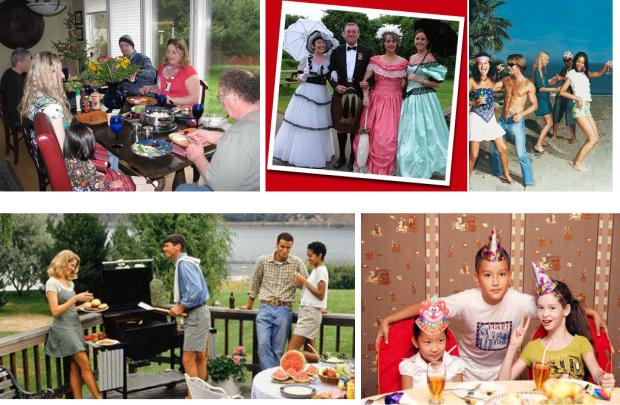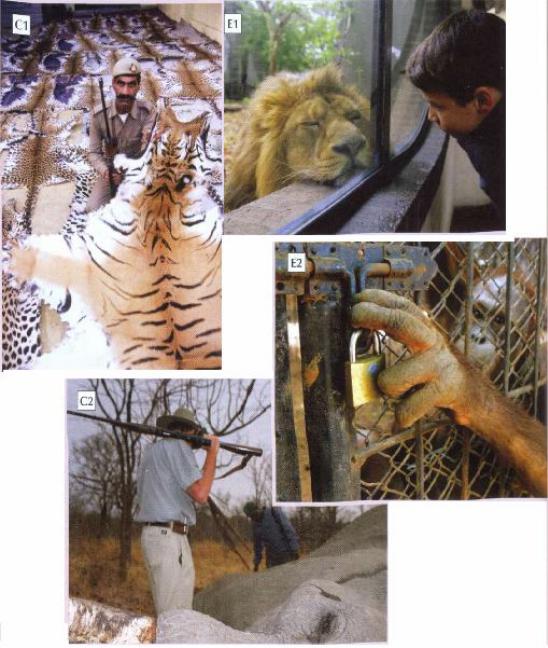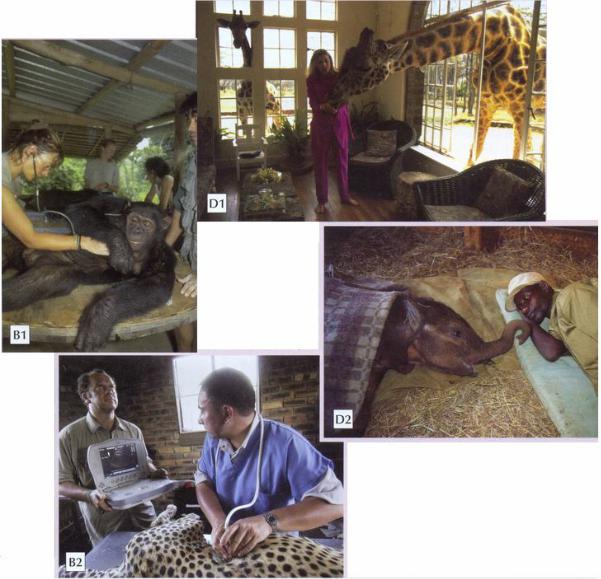
voronina_ev_sotsialnokulturnaia_sfera_obshcheniia
.pdf
4.c Listen to talk. Which of these statements about parties in the UK do you think are true?
1People usually wear formal clothes at parties.
2People take flowers or chocolates when they go to someone’s house for dinner.
3Teenagers sing songs and play games at parties.
Listen and check your predictions.
4.d Listen again and complete the phrases below.
Advice |
|
|
|
|
|
|
||||
1 |
If it’s very formal, you |
|
dress smartly. |
|||||||
2 |
Nowadays, for most parties you |
|
|
be too formal. |
||||||
3 |
It’s |
arrive late for a dinner party. |
|
|||||||
4 |
It’s |
|
|
take something with you. |
||||||
5 |
You |
|
|
|
always thank your host when you leave. |
|||||
6 |
You |
|
drink too much at parties. |
|||||||
7 |
You |
|
|
accept a lift home from a person you don’t know. |
||||||
|
|
|
|
|
|
|
|
|
|
|
111
4.e Look at the sentences from the radio programme. Underline the multi-part verbs.
1It depends on what kind of party it is.
2I never put a tie on.
3We get together to dance and play music.
4You don’t have to dress up.
5You can turn up when you want.
Match the verbs (1-5) above with the definitions (a-e).
ato arrive at a place
bto wear smart clothes
cto vary according to the situation
dto meet people
eto put clothes onto your body
4.f Use the phrases from ex. 4.d, 4.e to prepare some advice for a foreign visitor who is invited to these celebrations in your country.
a birthday party, a wedding reception, a New Year’s Eve party
Mention the following points:
clothes to wear (male/ female)
presents to take
time to arrive
things to say
things not to do
time to leave
Work in pairs. Student A is a foreign visitor and Student B gives advice. Ask and answer questions. Then swap roles.
Example
AI’m going to a wedding. What should I wear?
BYou should wear formal clothes – a jacket and tie.
AWhat should I take?
4.g Match the situations (a-e) with the expressions (1-5) below.
asomeone has passed an exam
bsome friends have had a baby
csomeone has won a match
dit’s someone’s birthday
esomeone is going to get married
112

Congratulations!
1Happy birthday! Have a lovely day!
2Well done! You played brilliantly!
3Congratulations! You worked hard for it.
4Wow! That’s brilliant. When’s the big day?
5That’s really great news. What are they going to call her?
Listen and repeat the underlined expressions above.
Work in pairs. Take turns to tell your partner some good news. Give congratulations using the expressions above.
Example
AI’ve passed my driving test!
BThat’s great! Well done.
AThanks. I’m really pleased.
4.h Tell about the differences between parties in your country and in the UK.
5. Extra Activities: Celebration of Christmas
5.a Below are the descriptions of how people in different countries celebrate Christmas. Read the texts and match them with the countries.
France
Brazil
Japan
Mexico
Italy
5.b Mark the words and phrases denoting the objects/events peculiar for every country.
5.c Mark the words and phrases denoting the objects/events common for all the countries.
1.
The festivities start on December 16. Each night for nine nights before Christmas, families go to each other's homes for parties, or posadas. Each posada starts with a parade of all the guests. The paraders
go to a door of the host's house and knock. The host calls out that there is no room in his house. The guests continue to sing and knock, and finally they are invited in. The holy
113
figures are placed on an altar and the |
midnight, the people go to church. |
||||||||||||
people pray and sing. |
|
|
|
After church, a large feast is held. |
|||||||||
On Christmas Eve, the largest |
Sometimes gifts are exchanged, but |
||||||||||||
posada of all is held. There are |
children often wait until King's Day |
||||||||||||
fireworks |
and |
noisemakers. |
At |
(6 |
Jan) |
to |
receive |
gifts. |
|||||
In this country |
2. |
|
|
|
|
|
|
|
|
|
|
||
Christmas arrives |
beach and participate in an African |
||||||||||||
at the beginning of summer. There is |
spiritualist |
ceremony |
that |
honors |
|||||||||
no snow or cold, but in spite of the |
'Lemanja', the goddess of the sea. |
||||||||||||
heat, Santa Claus known here as |
Then on Epiphany or Three Kings' |
||||||||||||
"Papai Noel" wears the traditional |
Day Children put their shoes beside |
||||||||||||
costume as seen in countries where it |
the window or outside the door, |
||||||||||||
is winter. The celebration runs from |
hoping to find them filled with treats |
||||||||||||
December 25th to Jan 6th (Three |
the next day, supposedly by the three |
||||||||||||
Kings' Day), lasting 12 days. People |
wise men. This officially ends the |
||||||||||||
attend Mass on Christmas Eve, where |
Christmas season. |
|
|
||||||||||
the Christmas story is retold. One |
|
|
|
|
|
|
|
||||||
week later on New Year's Eve, many |
|
|
|
|
|
|
|
||||||
people will |
flock to |
Copacabana |
|
|
|
|
|
|
|
||||
|
|
|
3. |
|
|
|
|
|
|
|
|
|
|
Most families enjoy two creches |
by Pere Noel. Birch sticks are |
||||||||||||
(Nativity Scene). The first is in their |
sometimes left as a reminder to be |
||||||||||||
own church. The other is at home. |
good. Ashes from the Yule log are |
||||||||||||
Holly and greens are purchased for a |
saved and used during the year to |
||||||||||||
backdrop. A lighted star is always |
ward off sickness, or other |
||||||||||||
suspended over the creche. The |
misfortunes. |
|
|
|
|
|
|||||||
family gathers around and sings |
The children go to bed early to |
||||||||||||
carols as the Jesus is placed in the |
dream of their Christmas miracle. |
||||||||||||
manger. The three kings are placed |
They place wooden shoes near the |
||||||||||||
there on Epiphany eve, (6 Jan). A |
fireplace or under the tree. The shoes |
||||||||||||
special cookie is baked. Some feel it |
are filled with candies, oranges and |
||||||||||||
must first be shared with needy |
chestnuts. Christmas |
presents are |
|||||||||||
people. |
|
|
|
|
|
|
given on New Year's Day. |
|
|||||
Christmas Eve is for gift giving, |
|
|
|
|
|
|
|
||||||
Shoes are left by the fire to be filled |
|
|
|
|
|
|
|
||||||
Several |
days |
|
4. |
|
|
|
|
|
|
|
|
|
|
before Christmas, |
bagpipes, flutes and oboes, on which |
||||||||||||
children go door to door singing |
they play sweet holiday music. On |
||||||||||||
favorite Christmas carols. They are |
Christmas Eve, many candles are lit |
||||||||||||
often accompanied by pipers wearing |
as the children in the family take |
||||||||||||
bright red jackets and broad-brimmed |
turns |
telling |
the |
wonderful |
story of |
||||||||
hats with red tassels. |
They |
carry |
|
|
|
|
|
|
|
||||
114

Christmas and the birth of the holy "Bambino."
At this time, families gather around their beloved "Presepio," a shrine to the Holy Child, and pray. After a 24-hour fast, all members of the family then sit down to a feast of delicious lasagna and spaghetti. On the 12th day of the holidays (6 Jan) a
kindly old witch known as "La Befana" brings gifts to the children. La Bafana is often shown as being old and ugly, but children love her very much. That is unless they have been naughty, for then their shoes will be filled with coal and ashes instead of candy and gifts.
5.
This is not a predominantly Christian country, but Christmas has become a holiday that many people there enjoy. Homes are decorated with evergreens, special meals are prepared, and Christmas songs sung. Santa, called Hoteisho, may visit some of the homes. Children believe that he has eyes on the back of his head so he can see all the good and bad things they do. More than Christmas, children look forward to New Year's Day. All the homes are cleaned and scrubbed, then decorated
with evergreens, bamboo, or flowers. Special rice cakes are made. Everyone pays all their bills, so that they will not be starting the new year in debt. On New Year's Eve, temple bells ring 108 times to show the old year is over and the new one is beginning. People put good luck poems under their pillows as they go to bed to bring good fortune in the coming year. On New Year's Day everyone wears their finest clothes. Gifts are often exchanged at this time.
6. Listening
6.a Work in pairs and discuss the questions.
Is April Fool’s Day celebrated in your country?
Do people play jokes on each other?
What kinds of tricks were you taken in by?
Is there a tradition in your country to deceive people through TV, radio or newspapers and online?
6.b Match the phrases which you will come across in the following exercise with their definitions:
115

practical |
a someone who believes things easily, even if it's obvious that |
joke |
they're not true |
hoax |
b to believe something that isn't true |
taken in by |
c to trick people into believing something that's not true, usually |
|
on a larger scale |
gullible |
d a practical joker |
prankster |
e a type of joke which is played at someone else's expense |
6.c Listen to the people discussing how April Fool’s Day is celebrated in England. Match the speakers with what they say.
Kate |
A My flatmate changed my clock so I ended up getting up a whole |
|
hour earlier than I needed to. |
Jackie |
B If somebody makes somebody else look rather silly, by telling |
|
them something that isn’t true, by playing a practical joke on them. |
Carrie |
C Traditionally in England the jokes only last until noon midday. |
6.d Listen again and decide whether the statements below are true (T) or false (F).
1Jackie didn’t realise that her flatmate had played a joke on her.
2On April Fool’s Day people are allowed to play a trick on someone they know.
3The people in charge of the media rarely play tricks on their audience.
4In 1965, the BBC started broadcasting smells through the airwaves.
5In Ireland, France, and the USA, the jokes can be played all day.
6.e Tell about the way April Fool’s Day is celebrated in England.
7. Writing and Speaking: Project Work
6.a Find some information on one of the following topics (you can use any information available on the Internet or in books / magazines):
the most exciting festivals in the world
unusual festivals / traditions
the festivals I’d like to take part in
116

Write theses in order to give a brief oral presentation (5-6 minutes) of the topic you’ve chosen. Don’t forget to
include some visual aids (Power Point Microsoft software can help you)
structure your theses
include the phrases which will help your audience follow what you’re talking about (see ex.6.b).
6.b Match the phrases in the box with the appropriate point in the presentation plan.
Today I’ll be showing you/ reporting on … The subject / topic of my presentation is … Let’s now look at the next slide which shows
…
Are there any questions?
My presentation will take about 10 minutes. There will be time for questions after my presentation.
To conclude / In conclusion, I’d like to …
In this part of my presentation, I’d like to talk about …
I’d like to summarise what I’ve said so far … So much for point two.
It’s a pleasure to welcome you today Let’s now move on / turn to …
Well, that brings me to the end of my presentation.
Let me just start by introducing myself. My name is …
I’ve divided my presentation into three main parts.
1Introduction
a welcoming the audience b introducing yourself
cintroducing your topic and purpose
dmentioning the structure, timing and question time of the presentation
2 The main part
asaying what is coming
bdescribing visuals
csummarising every point
eindicating the end of the section and moving to the next part
3 Conclusion
aindicating the end of your talk
bsummarising points
cinviting questions
117

Picture Bank
118

Pictures for student B.
119
Учебное издание
СОЦИАЛЬНО-КУЛЬТУРНАЯ СФЕРА ОБЩЕНИЯ
Учебно-методическое пособие для студентов естественно-научных факультетов
Составители: Воронина Елена Владимировна,
Дробышева Татьяна Владиславовна, Кривенко Людмила Александровна
Подп. в печ. 23.07.2010. Формат 60×84/16.
Усл. печ. л. 7,0. Тираж 300 экз. Заказ 1016.
Издательско-полиграфический центр Воронежского государственного университета.
394000, г. Воронеж, пл. им. Ленина, 10. Тел. (факс): +7 (4732) 598-026 http://www.ppc.vsu.ru; e-mail: pp_center@ppc.vsu.ru
Отпечатано с готового оригинал-макета в типографии Издательско-полиграфического центра
Воронежского государственного университета. 394000, г. Воронеж, ул. Пушкинская, 3. Тел. 204-133
